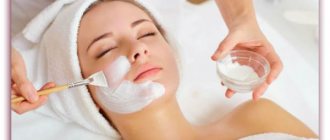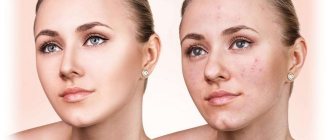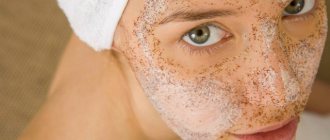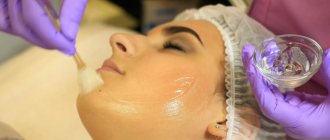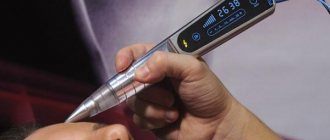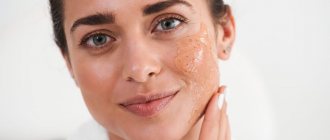What is a chemical facial peel?
The cells of the outer layer of skin (epidermis) are able to renew themselves; in youth, no additional external efforts are usually required for this. But with age, renewal processes slow down and require stimulation. In modern cosmetology, there is a highly effective and safe method that stimulates exfoliation and removal of the stratum corneum - exfoliation, or peelings.
Chemical peeling is a salon procedure aimed at intensive exfoliation of dead cells of the outer layer of skin using special substances - acids. In other words, chemical peeling removes dead cells, thereby stimulating the renewal processes of the epidermis and dermis.
In addition to various acids (glycolic, fruit, lactic, etc.), the compositions of chemical peels may also contain other highly effective components that have anti-inflammatory, whitening, nourishing and healing properties, so the peeling procedure is increasingly gaining popularity, becoming one of the most popular procedures in modern cosmetology.
Chemical peeling stimulates the body's protective functions, which leads to increased production of hyaluronic acid, collagen and elastin - these substances are responsible for the structure of the skin, its youth and elasticity. The result of exfoliation is an improvement in skin tone, smoothing out unevenness, acne marks and fine wrinkles. In addition, peeling procedures also help fight pigmentation.
Depending on the degree and depth of exposure, there are several types of chemical peels.
The structure of the skin
To understand how acid peeling works, it is worth considering the structure of the skin. For what? Because each substance affects a specific layer of the skin. They act on tissues with different forces. So, the skin consists of three layers:
- Epidermis is the top layer. It is in it that the processes of renewal and development of epithelial cells take place. In addition, it protects tissues from the influence of external negative factors. The epidermis is affected by the active components of various creams and other cosmetic compositions intended for skin care.
- The dermis is the layer located below the epidermis. A basal dividing membrane is provided between them. The dermis consists of the reticular and papillary layers. The first of them contains most of the collagen fibers. The condition of the skin depends on the condition of the reticular layer of the dermis.
- Hypodermis is adipose tissue, or subcutaneous tissue. It is located under the dermis layer. The hypodermis takes part in the processes of thermoregulation of the whole organism. This is where nutrients and water accumulate.
As mentioned above, acid peeling affects certain layers of the skin. It all depends on the active components included in the product. Therefore, a cosmetologist should select medications for the procedure. In this case, much depends on the condition of the patient’s skin. At home, acid peeling for the face can be carried out using only those products that affect the outer layer - the epidermis.
Types of chemical facial peels
There are three main types, which are primarily determined by the depth of acid exposure: superficial, middle and deep.
Superficial chemical peeling
Superficial peeling is the mildest type, which is suitable for almost everyone. A special composition containing acid penetrates only into the upper layers of the epidermis; it has a gentle effect, dissolving dead skin particles without damaging or irritating the skin. The result is normalization of the sebaceous glands, narrowing of enlarged pores, drying out acne; the face gains radiance and an even tone.
Acids that are often used for superficial peeling are lactic, fruit, and less often - glycolic, carbonic.
Medium chemical peel
This is a more serious cleansing method: the acid penetrates deeper than the stratum corneum - into the middle layers of the skin located under the epidermis. The process of cell exfoliation affects not only the superficial, but also deeper layers. Medium peeling makes wrinkles, pigmentation, acne marks and scars less noticeable. The face becomes elastic, toned and fresh.
The acids most commonly used for medium peels are trichloroacetic (TCA), salicylic and retinol (vitamin A).
Deep chemical peeling
This is one of the most radical types of skin cleansing and renewal, carried out strictly in a hospital setting. Deep chemical peeling is controlled damage to the superficial and deep layers of the skin in order to exfoliate the epidermis and further intensive process of tissue regeneration (restoration). Used to eliminate scars, scars, as well as deep wrinkles and other signs of aging. The result after the procedure is completely renewed skin without signs of aging. However, do not forget that this type of peeling is nothing more than a deep chemical burn of the face; it involves a long, multi-month (up to 6 months) rehabilitation process. In modern cosmetology, deep chemical peeling is rarely used; preference is given to more gentle and safe methods.
When carrying out deep chemical peeling, compositions based on phenol (carbolic acid) are used.
How does the procedure affect the condition of the skin?
How does acid peeling for the face work? Reviews, photos before and after the procedure do not provide an accurate explanation. Therefore, the issue is worth considering in more detail. The principle of the procedure is to injure tissue by causing burns to certain layers of the skin. As a result, regeneration processes are activated in the body.
At first glance, this method may seem cruel. However, thanks to the procedure, youth can be restored. Acid peeling can eliminate minor wrinkles, give the skin a healthy tone, and also get rid of scars that have arisen as a result of removing blackheads or acne.
Peeling effect
Superficial chemical peeling tightens enlarged pores, eliminates dryness and acne. Thanks to the improved supply of oxygen and nutrients to cells, the condition of the skin improves, the face becomes more radiant and fresh.
Medium chemical peeling helps solve the problem of pigmentation and makes fine wrinkles and tubercles less noticeable. Complexion and relief are evened out.
The achieved effect of deep chemical peeling is very high. With its help, it is possible to get rid of significant wrinkles and sagging face; deep peeling also solves such a complex problem as removing scars and shallow scars. After a long recovery, the skin becomes tightened and more resistant to age-related changes.
To achieve maximum results, it is important to contact a specialist who will select the most suitable type of peeling for your skin type, based on its condition. Chemical peels at home are not recommended.
Hydra Sparkling One-minute Glow Powder Daily Micropeeling
The product was developed by Givenchy.
The most interesting thing is that it comes in powder form. Its texture resembles powder. Upon contact with water, it begins to dissolve and turn into a foam that is pleasant to the touch. Each particle of such powder is a microgranule, which consists of active components: hyaluronic, glycolic and salicylic acid, hydrolyzed protein. According to reviews, this composition is consumed sparingly and is intended for daily use. This peeling is ideal for sensitive skin. How to use it? It is necessary to pour a little powder into the palm of your hand, dilute with water, and then apply to the skin of the face, while making massaging movements with your fingertips. After 1 minute, the product should be washed off with water. As a result, the skin becomes smooth and radiant, and the pores are cleared of oil and dirt.
The cost of one container of powder is 2990 rubles.
What problems does peeling solve?
As a rule, exfoliation is recommended for aged (after 35 years) and problem skin. The main indications for prescribing peelings include:
- dry, dull, aging skin
- long-term inflammatory skin diseases, such as acne and acne, which are characterized by the formation of pustules (pustules), comedones (blackheads) and, as a result, scars
— wrinkles (age-related, expression lines)
— premature age-related changes in the skin due to exposure to ultraviolet rays (photoaging)
– pigmentation (dark spots and freckles)
- scars, cicatrices, loss of clarity of the oval of the face
Who is the procedure not recommended for?
Contraindications to exfoliation are:
- herpes infection and other infectious diseases in the active stage
- diseases of the kidneys, liver, cardiovascular system, cancer and other severe somatic diseases
- diabetes
– pregnancy and breastfeeding period
- minor age (under 18 years old)
- individual intolerance and allergic reaction to the ingredients of the composition
- damage to the skin, inflammation of the skin
Before the exfoliation procedure, consultation with a specialist is necessary in any case, because In addition to absolute contraindications, there are other reasons that may justify postponing the procedure for some time. Thus, peeling is not recommended while taking a number of medications (immunosuppressants, retinoids, etc.) or in the case of recently performed traumatic cosmetic procedures (deep cleaning, mesotherapy, etc.). In addition, contraindications also include the presence of a tan and menstruation period.
When to give up
Acid peeling is a complex procedure. Therefore, before carrying out it, you should familiarize yourself with the contraindications. The procedure is prohibited:
- in case of individual intolerance to any of the components of the composition;
- for allergies;
- with acute herpes;
- in the presence of keloid scars;
- during lactation and pregnancy.
Acid peeling should only be performed from November to March. In warm weather, such a procedure can cause the development of irreversible processes in the layers of the skin. Therefore, during active sun exposure, peeling using acidic compounds is strictly prohibited.
How does a cosmetologist peel?
Chemical peels, which are used in cosmetology, penetrate deeper into the skin, so they are an order of magnitude more effective than home peeling options. In addition, it is extremely important to carry out the procedure correctly to avoid unwanted consequences.
First stage
– This is preparing the skin for the procedure and cleansing it. Using special products, the skin is degreased, cleansed of impurities (cosmetics, dust) and skin secretions; For the desired result, high-quality facial cleansing and the formation of the acid-base balance of the skin are extremely important.
Second phase
– application of the composition. The sequence of application and duration of peeling is determined by a qualified cosmetologist depending on the composition of the drug and the condition of the patient’s skin.
Third stage
– neutralization of peeling. Modern formulations do not require special chemical neutralization. The client washes off the peeling independently after 6-8 hours at home.
Fourth stage
– post-peeling care. To consolidate the results and protect the skin, the cosmetologist applies special cosmetics and also gives recommendations for further facial skin care.
Ultra Gentle Exfoliating Gel
Our list of the best acid peels for the face includes Ultra Gentle Exfoliating Gel.
It is produced by Ultraceuticals. Its cost is 5040 rubles. The gel itself is considered multifunctional. It can be used to tighten pores, cleanse them, and moisturize the skin. The gel contains salicylic and lactic acid. Moreover, the product does not contain abrasive particles. When applied, microspheres are felt that cleanse the skin without damaging the outer layer. The peeling does not dry out, but gently exfoliates.
It is worth noting that it contains glycerin, bisabolol, intended to relieve inflammation, and eucalyptus oil, which is excellent disarming. The gel is suitable for all skin types, especially those prone to inflammation and oily sheen. This composition can be used 1-4 times every 7 days, but experts recommend carrying out the procedure no more than 3 times a week.
Recovery period
The duration of recovery after the procedure depends on the depth of acid exposure. So, after superficial peeling, recovery will take several days, after medium peeling – up to 14 days. Skin regeneration processes after deep peeling require more time - up to six months.
Regardless of the type of peeling and the duration of the recovery period, it is important to take care of your facial skin and follow your doctor’s recommendations. There are few restrictions during this period, but it is highly advisable to comply with them; first of all, it is to refrain from visiting the bathhouse, sauna and, of course, the solarium. Protecting the skin from ultraviolet rays, even in winter, is also the main rule during the recovery period. It is recommended to drink plenty of fluids and touch your face as little as possible.
In addition to generally accepted restrictions, there may be individual ones, which are prescribed by a cosmetologist. A professional specialist will also give recommendations on the use of skincare and decorative cosmetics during the recovery period after the procedure.
